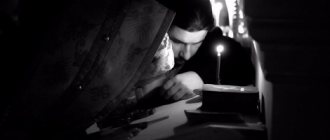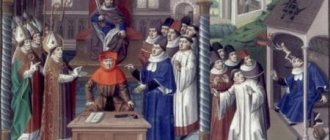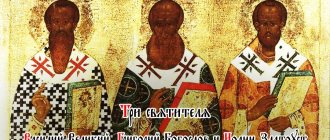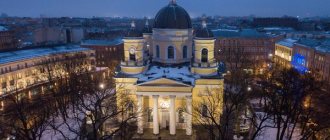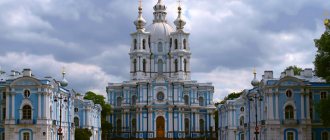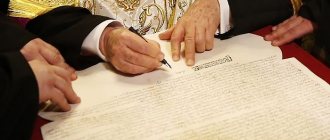Article of Faith
After this, at the Council of Chalcedon in 451, the official adoption of a new doctrinal Christological definition took place. It was important to present the doctrine of two natures in the person of Jesus Christ, which would be alien to the extremes that existed in Monophysitism and Nestorianism. It was necessary to develop something in between; such a teaching had to become Orthodox.
It was decided to take as a model the statement of faith made by John of Antioch, Cyril of Alexandria, as well as the message of Pope Leo I sent to Flavian. Thus, it was possible to develop a dogma about the image of the union of two natures in the person of Jesus Christ.
This definition of religion condemned both Monophysitism and Nestorianism. Theodritus, who was present at the council, whom the Egyptian bishops suspected of Nestorianism, issued an anathema against Nestorius and also signed his condemnation. After this, the council decided to lift the condemnation imposed by Dioscorus and reinstate him. Also, the convictions of the Edessa Bishop Iva were lifted.
Only the Egyptian bishops continued to behave ambiguously as before, who did not fully demonstrate their attitude towards religious determination. On the one hand, they signed the condemnation of Eutyches, but at the same time they did not want to support the letters of the Pope to Flavian, explaining this by the custom existing in Egypt, according to which they cannot make any significant decisions without the determination and permission of their archbishop. And after the deposition of the previous archbishop by Dioscorus, they simply did not have a new one. The council participants urged them to swear that they would sign the necessary papers as soon as the archbishop was elected.
As a result, the number of signatories to this decision, known as the dogma of the Council of Chalcedon, was approximately 150 people less than the number who gathered for the council. When Emperor Marcian was informed of the official decision, he and Pulcheria came to the sixth meeting, at which he made a speech. In it, he expressed his joy that everything was done peacefully and according to common desire. If you believe the Aramaic protocols that have come down to us, Marcian’s speech was enthusiastically received by those present, who accompanied it with bright exclamations.
List of participants
The Council of Chalcedon in 451 was presided over by Anatoly of Constantinople, who had become patriarch two years earlier. Before Marcian ascended the throne, he made an important decision for himself and went over to the side of the Orthodox. In total, from 600 to 630 fathers were present at the council, including representatives of the presbytery, who could replace one or another bishop.
Of the most famous participants in the Council of Chalcedon in 451, it is worth noting:
- Damian of Antioch, who had previously been deposed by Dioscorus, but then returned from prison after Marcian came to power;
- Maximus, who took the place of the first Patriarch of Jerusalem, Juvenal;
- Thalassius of Caesarea-Cappadocia;
- Bishop of Cyrus, Blessed Theodoret;
- Dioscorus of Alexandria;
- Eusebius of Dorylaeus.
Pope Leo I, who insisted that the council be convened in Italy, again did not attend it himself, but still sent his legates. In their capacity, Presbyter Boniface, as well as Bishops Lucentius and Paschazin, came to the Council of Chalcedon.
Also at the cathedral was a large number of high-ranking officials, among whom were senators and dignitaries who took an active part in its work. The only exceptions were those cases when it was necessary to consider exclusively church matters, for example, the trial of a bishop.
Causes
It is noteworthy that there were religious and political reasons for convening the Council of Chalcedon. The religious ones were that the Alexandrian Patriarch Discorus continued the work of his predecessor Cyril in the fight against Nestorianism. This is the so-called teaching of the Archbishop of Constantinople Nestorius, which was condemned as heresy at the previous Ecumenical Council of Ephesus in 431. In fact, it is a variant of the development of the Antiochian theological school, to which John Chrysostom belonged. At the same time, the main principle of Nestorianism is the recognition of the complete symmetry of the God-manhood of Christ.
After 431 years, Dioscorus decided to put an end to this issue at the so-called Ephesian “Robber” Council, held in 449. The result was the replacement of the dual Nestorian nature of Christ with the council's decision on a monolithic Monophysite nature.
However, such a formulation was fundamentally at odds with the message sent by Pope Leo I the Great to Archbishop Flavian of Constantinople, as well as with the council itself in 449. It is worth noting that Leo I himself did not take part in the work of the cathedral, since Attila’s troops were near Rome at that time. The pope sent legates to this council, who were supposed to defend its formulations, but they failed to fulfill their task. As a result, decisions later recognized as heretical were approved by the Eastern Roman Emperor Theodosius II.
After his death the situation changed dramatically. His sister Pulcheria, who had the official title of Augusta, married Senator Marcian and placed him on the throne. She was a supporter of Pope Leo I. In addition, it is known that Dioscorus managed to turn the imperial couple against himself, which led to such a quick convening of the IV Ecumenical Council.
Among the political reasons for convening the Council of Chalcedon in 451, it should be noted that both its convening and control by the emperor and his administration were provoked by the desire to ensure religious unity in the territory of the Eastern Roman Empire. This was supposed to contribute to its internal political stability.
The rivalry between the Patriarchs of Alexandria and the Patriarchs of Constantinople continued, which began after the Council of Constantinople in 381 placed the see of Constantinople in second place after Rome, displacing the See of Alexandria into third place. All this threatened the unity of the entire empire.
The idea that the strength and unity of the entire state depends on a single faith in the correct Trinity can also be found in letters to the emperor from Pope Leo I. The relevance of this thesis was indirectly confirmed by events that occurred shortly before in North Africa. An armed struggle against the Donatist schism began there, followed by the conquest of Carthage by the Vandals in 429, to whose side circumtillions also went over.
Place and time
According to the edict adopted by the emperor, initially all the bishops gathered in the ancient city of Nicaea, which is located on the territory of modern Turkish Iznik.
But soon after this they were all summoned to Chalcedon, which was located much closer to the capital. Therefore, the emperor had the opportunity to personally attend the meetings. They were directly supervised by his officials. In particular, the commander-in-chief Anatolius, the prefect of Constantinople Tatian and the prefect of the Praetorium of the East Palladius.
Meaning
After these decisions were approved by the emperor, on the basis of the oros of the Council of Chalcedon, that is, the dogmatic definitions of Orthodoxy, strict laws were issued against the Monophysites. Everyone was ordered to accept only the teachings defined at the council of 451. At the same time, the Monophysites were subjected to persecution and persecution. They were imprisoned or expelled. Dissemination of their works was punishable by death, and the books themselves were ordered to be burned. Eutyches and Disokor were exiled to distant provinces.
At the same time, the council failed to put a final end to the Christological disputes. But it was his definition of religion that over many subsequent centuries became the basis for Catholicism and Orthodoxy.
At that time, it was no longer possible not to notice the beginning of the disintegration of the Byzantine Empire. On the outskirts, separatist uprisings became increasingly stronger, which had a national basis, at the same time, in accordance with the spirit of the times, they sought to find justification and expression in the main dogmatic differences.
The authority of the council of 451 was restored in 518 at a council assembled in Constantinople by Patriarch John. It was attended by about 40 bishops who were in the capital at that moment, as well as abbots from the surrounding and capital monasteries. At the council, everyone who condemned the decisions taken at Chalcedon was severely condemned. Among them were the Patriarch of Antioch Sevier, and the memory of the fallen champions of Orthodoxy was also justified. The very next year after this council, reconciliation between the Eastern Church and Rome was achieved; a letter was signed by Pope Hormizda, which completed the Acacian schism. Under this name, a 35-year dispute between the Constantinople and Roman churches entered history.
It is interesting that the Coptic historiographer Severus in his “History of the Alexandrian Patriarchs” gives a non-standard assessment of the council in Chalcedonia in the chapter devoted to the fate of Dioscorus. In it, he notes that Dioscorus became the patriarch of Alexandria after the death of Cyril, but suffered severe persecution for his faith from the emperor Marcian and his wife. Following the Council of Chalcedon, they drove him from the throne.
Apostolic canons with interpretations
The public and secret life of the church is revealed by the rules of the holy Apostles.
Historical reference
The public mention of the rules of the Apostles dates back to the Council of Trullo, the theme of which was discipline in the holy bosom of Christianity.
“...so that from now on... the eighty-five rules accepted and approved by the holy and blessed fathers who lived before us, as well as the eighty-five rules handed down to us in the name of the holy and glorious Apostles, remain firm and indestructible.”
2nd Rule of the Council of Trullo, 692
There are opinions that the rules of the Apostles were compiled:
- by the Apostles and transmitted through the 4th Pope Clement;
- according to the norms in force since apostolic times;
- bishops at the beginning of the 4th century;
- by an anonymous author in the 5th century.
Essence and content
Until now, these rules are fully recognized only by the Orthodox Church. Their authority was gained partially and gradually. Some churches refused to accept them into their code.
The essence of the rules is consistent with the theme of the Trullo Cathedral. These are discipline, hierarchy and moral qualities of the clergy.
The Importance of Rules for the Church
Church canons are the cornerstones of faith. These include the most important rules of the early centuries of the Church, named after the Apostles.
The apostolic works bear witness to:
- the joy of the church finding “much gain”;
- faith that they are “enlightened” by the one Spirit;
- consent of churches to anathematize or excommunicate and subject to penances according to the rules.
Condemnation of Monophysitism
One of the main resolutions of the Ecumenical Council of Chalcedon was the condemnation of the heretical teaching of Eutyches. In fact, the council began with a review of the decisions taken at the so-called “robber” council in Ephesus in 449, and also began the trial of Dioscorus.
The prosecutor at the trial was Eusebius of Dorylaeus, who presented a detailed account of all the facts of violence that were committed by Dioscorus at the previous council, held two years earlier.
After the announcement of this document by the fathers of the Council of Chalcedon, it was decided to deprive Dioscorus of the right to vote, immediately after which he automatically became one of the defendants. In particular, it was testified that the act of that council could not be trusted, since then about a thousand monks, led by Varsuma, burst into the meeting and threatened the bishops with violence if they did not make the appropriate decisions. As a result, many put their signatures under threat of reprisals, some signed blank sheets.
In addition, accusations were received against Dioscorus from several Egyptian bishops, who accused him of cruelty, immorality and other violence. Dioscorus was condemned at the council and deposed, and the results and results of the “robber” council were actually canceled. It was decided to forgive the bishops who took part in it on the side of Dioscorus, since they repented of their actions, explaining that they acted under fear of threats that were regularly received against them.
Reaction of churches in Transcaucasia
It is worth noting that the council in the Church of Chalcedon took place without the participation of representatives of the churches of Transcaucasia. Having learned about the decisions taken there, the leaders of the Georgian, Armenian and Albanian churches refused to recognize them. In particular, they saw in the doctrine of the two natures of Jesus Christ an attempt to revive Nestorianism, which they were categorically against.
In 491, in the Armenian capital city of Vagharshapat, which had been the spiritual center of the Armenian people since the 4th century, a Local Council was held, in which representatives of the Albanian, Armenian and Georgian churches took part. It categorically rejected all the decrees and postulates adopted at Chalcedon.
At that moment, the Armenian Church was in a deplorable situation due to the protracted bloody confrontation with Persia. The key moment of this confrontation was the Battle of Avarayr in 451, which took place between troops led by the Armenian commander Vardan Mamikonyan, who rebelled against the Sasanian Empire and the forced imposition of Zoroastrianism. The Armenian rebels were defeated; by the way, the size of the army of their opponents was more than three times larger.
Because of these events, the Armenian Church did not have the opportunity to follow the Christological disputes that unfolded in Byzantium and to reasonably express its position. When, during the period of Vahan Mamikonian, who served as the Persian governor in Armenia from 485, the country finally emerged from the war, it became clear that there was a lack of unity everywhere on Christological issues.
As a result, it is worth recognizing that the Council of Chalcedon, which Emperor Marcian so counted on, did not bring peace to the Universal Church. At that time, Christianity was at least divided into four major branches, each of which had its own definition of religion. In Rome, Chalcedonianism was considered dominant, in Persia - Nestorianism, in Byzantium - Miaphysitism, and in parts of Gaul and Spain - Arianism. In the current situation, the most acceptable for the Armenian Church was the belief in the one nature of Christ, which existed among the Byzantines.
There were several reasons for this. Firstly, it almost completely corresponded to the faith of the Armenian Church itself, and secondly, unity in faith with Byzantium was more preferable for the Armenian Church than with any other. That is why at the Council of Dvina in 506, which was attended by bishops from Georgia, Armenia and Albania, the religious message of the Byzantine Emperor Zeno was officially accepted by the Armenian and other neighboring churches. At the same council, Nestorianism was once again condemned, and the decisions of the council of Chalcedon were assessed as a factor that contributed to its development.
In 518, the new emperor Julius came to power, who condemned the message of Zeno, proclaiming the Council of Chalcedon holy and ecumenical for all churches in the empire. Justinian, who became his successor, finally decided to eradicate the very concept of Monophysitism from the Greek churches. But by that time, the Armenian Church had already managed to free itself from his pressure, so the religion established in Chalcedon could no longer influence it.
